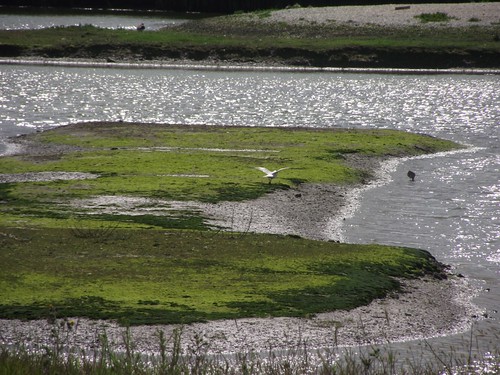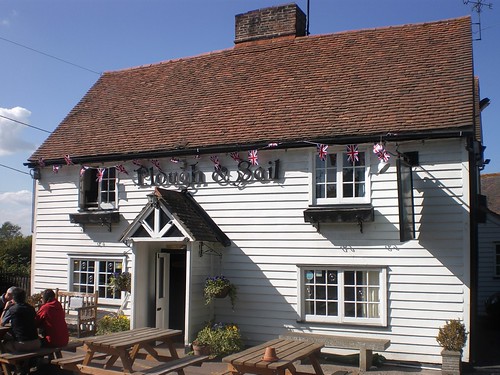(Click the photos for more pictures at the flickr site)
Lee Grandjean is a sculptor who spent some of his childhood in Harlow. Now resident in Norfolk, this piece was commissioned to mark the 21st anniversary of the Harlow Chorus, an amateur choir still going strong in the town. It is unusual in that it is one of, if not the only piece in the Harlow collection to be made from wood. Having stood outside since 1996, it may have seen better days but still regains it's elegance.
Sunday, 31 July 2011
Tuesday, 5 July 2011
Vange Marsh RSPB Nature Reserve
 |
| The saltwater lagoon / scrape at Vange Marsh |
Despite being relatively compact, they squeeze a good number of different habitats into the area - saltwater and brackish lagoons, a scrape, salt marsh, reed beds and heathland.
Now, I know very little about wildlife (bar what I learned watching springwatch) so I've decided to adopt Vange Marsh and get down there as often as possible over the year to see what is going on. It's exciting times for the RSPB locally as they are back working on the nearby Bowers Marsh reserve, and of course in 5 or so years time they will be taking over the land currently occupied by the Pitsea landfill site featured on Springwatch.
 |
| Moorhen and Chick |
Sunday, 26 June 2011
St Margaret of Antioch, Margaret Roding
 |
| St Margaret of Antioch, Margaret Roding |
The B&B, Garnish Hall, was interesting enough; a 14th century manor house. What really caught my eye, however, was the church next door. On the face of it, a parish church typical for small villages all over the place; it most likely would have been originally built for the lord of the manor with the chancel added when it was opened up to the wider community. What was most remarkable about it was this doorway:
To my eye, it seems completely out of keeping with the rest of the church and is quite unlike anything I've seen elsewhere. Unfortunately the need to get to the wedding reception meant that I was unable to take up the offer of a look inside, and the reason behind why a small parish church should have such a striking door will, for the moment at least, remain a mystery.
Monday, 30 May 2011
Paglesham and the Last Days of the HMS Beagle
 |
| HMS Beagle in Australia, from an 1841 Watercolour by Owen Stanley |
In a period after the Napoleonic wars, Britain's attentions turned to the expansion of their empire and the exploration of the already conquered territories. HMS Beagle went out as an exploration vessel, initially under the command of Commander Pringel Stokes for the first voyage of exploration then a Commander Robert Fitzroy for the second. Acknowledging the limitations of his information-gathering team, he determined to recruit a naturalist and scientist which brought him to meet Charles Darwin, the most famous man to have travelled on the HMS Beagle. It was on this voyage that Darwin made the observations that formed the basis of his "Origin of the Species".
HMS Beagle was to make one further voyage, to Australia, but then in 1845 the tired ship was passed to the Coastguard for use as a watch vessel. The rivers and creeks of the Essex coast around, and to the north of the Thames estuary, were prime smuggling territory and the river near Paglesham was no exception. The pub nearby, where I went for lunch a couple of weeks ago, was a notorious haunt for smugglers.
It wasn't a glamorous posting, but for former Navy men it offered the opportunity to live with their family as the Beagle was fitted out to accomodate 7 men and their families. There was plenty of work to be done as not only were smugglers to be deterred, the local oyster beds prized by the likes of Benjamin Disraeli, had to be protected.
Unfortunately the Beagle was not well maintained and as it began to disintegrate it had to be moved to a permanent berth in the Paglesham mud, where it finished its days. Eventually it was sold off. Initially believed to be scrapped, an investigation described in the book I bought in the pub, "Watch Vessel No. 7". The search concluded that the remains of a ship matching the dimensions of the Beagle could be detected beneath the Paglesham mud. There they will remain, unless money can be found for an archaeological excavation.
Unfortunately the Beagle was not well maintained and as it began to disintegrate it had to be moved to a permanent berth in the Paglesham mud, where it finished its days. Eventually it was sold off. Initially believed to be scrapped, an investigation described in the book I bought in the pub, "Watch Vessel No. 7". The search concluded that the remains of a ship matching the dimensions of the Beagle could be detected beneath the Paglesham mud. There they will remain, unless money can be found for an archaeological excavation.
So far as I can see, the book isn't available on the internet, so if you want a copy you will have to visit the pub and take a walk along the sea wall...
Saturday, 14 May 2011
Sculpture Town: Wrestlers by Sally Doig
 |
| (Click on the photo to see more pictures at the flickr site) |
Saturday, 7 May 2011
Sculpture Town: Contrapuntal Forms by Barbara Hepworth
(Click on the photos to see more pictures at the flickr site)
Barbara Hepworth is one of the best known sculptors represented in the Harlow collection. Her works can be found everywhere from Oxford Street John Lewis to Winchester Cathedral. This piece was originally created for the Festival of Britain in 1951 when it stood proudly on the South Bank.
In music, contrapuntal refers to two lines going in different directions in one piece. Contrapuntal forms is one of a number of pieces in which Barbara Hepworth examined the relationship between two figures (See also this piece in the Tate collection). Although not as famous as her contemporary Henry Moore, her work, to my mind at least, deserves every bit as much recognition as Moore's.
Thursday, 5 May 2011
Sculpture Town: Sheep Shearer by Ralph Brown
(Click on the photos to see more pictures at the flickr site)
Another of the collections impressive bronzes, this piece was acquired by the trust in 1955, soon after it was set up. Ralph Brown is a Yorkshireman who studied sculpture at the Leeds School of Art, then the Hammersmith School of Art before studying at the Royal College of Art. It was during this time that he created Sheep Shearer. He subsequently taught and worked in various places, and is currently based in Gloucestershire.
Much of his work features everyday scenes of men and women, and this piece captures the sense of determination and struggle in the act of sheep shearing.
Subscribe to:
Posts (Atom)










